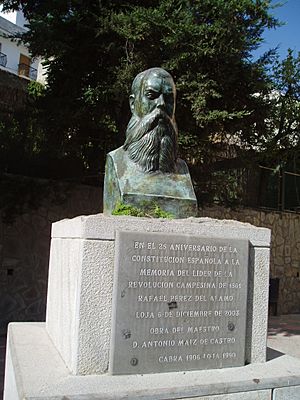Loja uprising facts for kids
The Loja uprising was a quick rebellion that happened in 1861. It took place in a town called Loja, in the Andalucia region of Spain. Many people see it as one of the first times people fought for socialist ideas in Spain.
Contents
The Loja Uprising
Why the Uprising Started
In the mid-1800s, Andalucia was a place where many people opposed the government. Queen Isabella II ruled Spain, and her family, the Bourbons, had been in power for a long time. Many people wanted Spain to be a republic instead of a monarchy.
A secret group called the Democratic Party started in 1849. This party became very popular with farmers and workers in Andalucia. They were unhappy because there was a lot of unfairness and poverty in the countryside. Some small peasant revolts had happened before, like in El Arahal and Utrera in 1857. But these earlier revolts were not mainly about politics.
How the Uprising Happened
On June 28, 1861, a local blacksmith named Rafael Pérez del Álamo led the uprising. He was also a leader in the Democratic Party. He marched with about 600 men to a nearby town called Iznájar. They took over the town easily.
Pérez del Álamo then read a special message. It talked about creating a republic and socialist ideas. He encouraged the people there to fight against the Queen's rule. The next day, Pérez del Álamo had gathered a much larger army. It had more than 10,000 armed men.
They marched to Loja and took control of the town by force. They announced that Loja was now a republic. Loja was an important place because it was the hometown of Ramón María Narváez. He was a powerful politician who had been prime minister many times.
The rebels, led by Pérez del Álamo, took things from the royal estates in Loja. They then shared out the land to the poorer people. Similar uprisings also happened in nearby towns like Archidona and Alhama de Granada. These were partly helped by secret groups and inspired by Garibaldi's recent successes in Italy.
The Uprising Ends
Pérez del Álamo hoped that the Loja uprising would cause other rebellions across Spain. He wanted members of the Democratic Party everywhere to rise up. However, a bigger national revolution did not happen.
The military leader of Granada sent soldiers to take back Loja. On July 4, 1861, the government troops fought the rebels. The rebels were defeated in a fierce battle. The remaining rebel forces, still led by Pérez del Álamo, escaped to Alhama de Granada.
There, they decided to march towards Granada itself. This was a last try to start more rebellions. But the rebel army was defeated again at Pilas de Algaida. Pérez del Álamo managed to escape and went to Madrid.
What Happened Next
After the Loja uprising, Queen Isabella visited the region in 1862. She wanted to calm down the people who were against her rule. She offered to forgive all the rebels who were still alive. This helped to stop the revolutionary feelings for a while.
However, the Queen was forced to give up her throne just six years later. This happened during the Glorious Revolution in 1868. This event marked the start of a period called the Sexenio Democrático. Loja would rise up against the government again in 1873. This happened during the Cantonal rebellion, when many parts of southern Spain rebelled.
See also
 In Spanish: Sublevación de Loja para niños
In Spanish: Sublevación de Loja para niños


